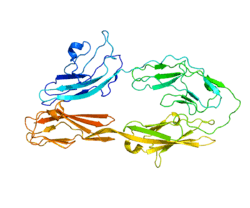NFASC
Neurofascin is a protein that in humans is encoded by the NFASC gene.[5][6][7]
Function
Neurofascin is an L1 family immunoglobulin cell adhesion molecule (see L1CAM) involved in axon subcellular targeting and synapse formation during neural development.[7][8]
References
- 1 2 3 GRCh38: Ensembl release 89: ENSG00000163531 - Ensembl, May 2017
- 1 2 3 GRCm38: Ensembl release 89: ENSMUSG00000026442 - Ensembl, May 2017
- ↑ "Human PubMed Reference:".
- ↑ "Mouse PubMed Reference:".
- ↑ Volkmer H, Hassel B, Wolff JM, Frank R, Rathjen FG (Jul 1992). "Structure of the axonal surface recognition molecule neurofascin and its relationship to a neural subgroup of the immunoglobulin superfamily". J Cell Biol. 118 (1): 149–61. PMC 2289533
 . PMID 1377696. doi:10.1083/jcb.118.1.149.
. PMID 1377696. doi:10.1083/jcb.118.1.149. - ↑ Burmeister M, Ren Q, Makris GJ, Samson D, Bennett V (Oct 1996). "Genes for the neuronal immunoglobulin domain cell adhesion molecules neurofascin and Nr-CAM map to mouse chromosomes 1 and 12 and homologous human chromosomes". Mamm Genome. 7 (7): 558–9. PMID 8672144. doi:10.1007/s003359900168.
- 1 2 "Entrez Gene: NFASC neurofascin homolog (chicken)".
- ↑ Ango F, di Cristo G, Higashiyama H, Bennett V, Wu P, Huang ZJ (October 2004). "Ankyrin-based subcellular gradient of neurofascin, an immunoglobulin family protein, directs GABAergic innervation at purkinje axon initial segment". Cell. 119 (2): 257–72. PMID 15479642. doi:10.1016/j.cell.2004.10.004.
Further reading
- Hortsch M (1996). "The L1 family of neural cell adhesion molecules: old proteins performing new tricks.". Neuron. 17 (4): 587–93. PMID 8893017. doi:10.1016/S0896-6273(00)80192-0.
- Nakajima D, Okazaki N, Yamakawa H, et al. (2003). "Construction of expression-ready cDNA clones for KIAA genes: manual curation of 330 KIAA cDNA clones.". DNA Res. 9 (3): 99–106. PMID 12168954. doi:10.1093/dnares/9.3.99.
- Tuvia S, Garver TD, Bennett V (1998). "The phosphorylation state of the FIGQY tyrosine of neurofascin determines ankyrin-binding activity and patterns of cell segregation.". Proc. Natl. Acad. Sci. U.S.A. 94 (24): 12957–62. PMC 24245
 . PMID 9371782. doi:10.1073/pnas.94.24.12957.
. PMID 9371782. doi:10.1073/pnas.94.24.12957. - Ren Q, Bennett V (1998). "Palmitoylation of neurofascin at a site in the membrane-spanning domain highly conserved among the L1 family of cell adhesion molecules.". J. Neurochem. 70 (5): 1839–49. PMID 9572267. doi:10.1046/j.1471-4159.1998.70051839.x.
- Zhang X, Davis JQ, Carpenter S, Bennett V (1998). "Structural requirements for association of neurofascin with ankyrin.". J. Biol. Chem. 273 (46): 30785–94. PMID 9804856. doi:10.1074/jbc.273.46.30785.
- Nagase T, Ishikawa K, Suyama M, et al. (1999). "Prediction of the coding sequences of unidentified human genes. XI. The complete sequences of 100 new cDNA clones from brain which code for large proteins in vitro.". DNA Res. 5 (5): 277–86. PMID 9872452. doi:10.1093/dnares/5.5.277.
- Koroll M, Rathjen FG, Volkmer H (2001). "The neural cell recognition molecule neurofascin interacts with syntenin-1 but not with syntenin-2, both of which reveal self-associating activity.". J. Biol. Chem. 276 (14): 10646–54. PMID 11152476. doi:10.1074/jbc.M010647200.
- Ratcliffe CF, Westenbroek RE, Curtis R, Catterall WA (2001). "Sodium channel beta1 and beta3 subunits associate with neurofascin through their extracellular immunoglobulin-like domain.". J. Cell Biol. 154 (2): 427–34. PMC 2150779
 . PMID 11470829. doi:10.1083/jcb.200102086.
. PMID 11470829. doi:10.1083/jcb.200102086. - Jenkins SM, Kizhatil K, Kramarcy NR, et al. (2002). "FIGQY phosphorylation defines discrete populations of L1 cell adhesion molecules at sites of cell-cell contact and in migrating neurons.". J. Cell. Sci. 114 (Pt 21): 3823–35. PMID 11719549.
- Jenkins SM, Bennett V (2002). "Ankyrin-G coordinates assembly of the spectrin-based membrane skeleton, voltage-gated sodium channels, and L1 CAMs at Purkinje neuron initial segments.". J. Cell Biol. 155 (5): 739–46. PMC 2150881
 . PMID 11724816. doi:10.1083/jcb.200109026.
. PMID 11724816. doi:10.1083/jcb.200109026. - Charles P, Tait S, Faivre-Sarrailh C, et al. (2002). "Neurofascin is a glial receptor for the paranodin/Caspr-contactin axonal complex at the axoglial junction.". Curr. Biol. 12 (3): 217–20. PMID 11839274. doi:10.1016/S0960-9822(01)00680-7.
- Kizhatil K, Wu YX, Sen A, Bennett V (2002). "A new activity of doublecortin in recognition of the phospho-FIGQY tyrosine in the cytoplasmic domain of neurofascin.". J. Neurosci. 22 (18): 7948–58. PMID 12223548.
- Strausberg RL, Feingold EA, Grouse LH, et al. (2003). "Generation and initial analysis of more than 15,000 full-length human and mouse cDNA sequences.". Proc. Natl. Acad. Sci. U.S.A. 99 (26): 16899–903. PMC 139241
 . PMID 12477932. doi:10.1073/pnas.242603899.
. PMID 12477932. doi:10.1073/pnas.242603899. - Gollan L, Salomon D, Salzer JL, Peles E (2004). "Caspr regulates the processing of contactin and inhibits its binding to neurofascin.". J. Cell Biol. 163 (6): 1213–8. PMC 2173730
 . PMID 14676309. doi:10.1083/jcb.200309147.
. PMID 14676309. doi:10.1083/jcb.200309147. - Ota T, Suzuki Y, Nishikawa T, et al. (2004). "Complete sequencing and characterization of 21,243 full-length human cDNAs.". Nat. Genet. 36 (1): 40–5. PMID 14702039. doi:10.1038/ng1285.
This article is issued from
Wikipedia.
The text is licensed under Creative Commons - Attribution - Sharealike.
Additional terms may apply for the media files.





